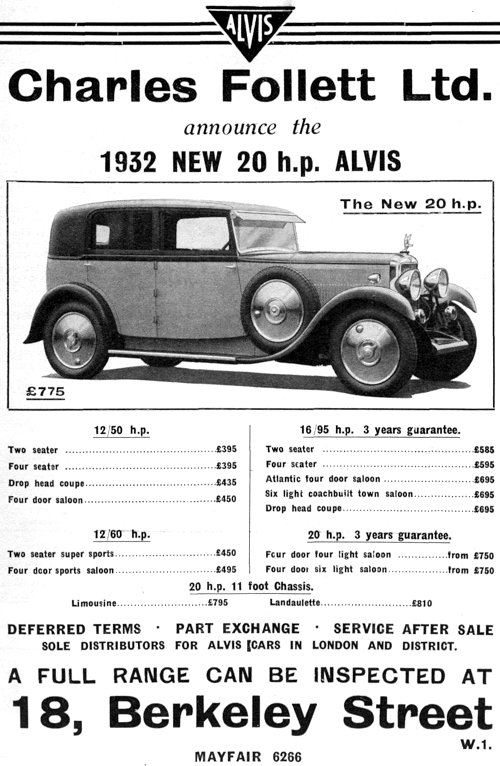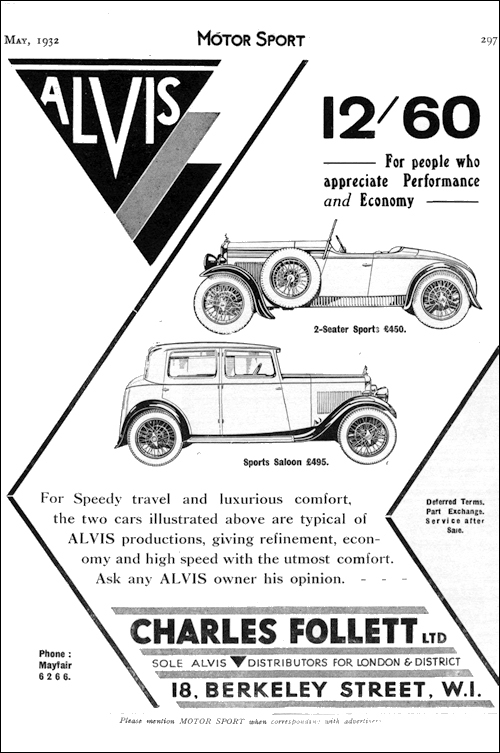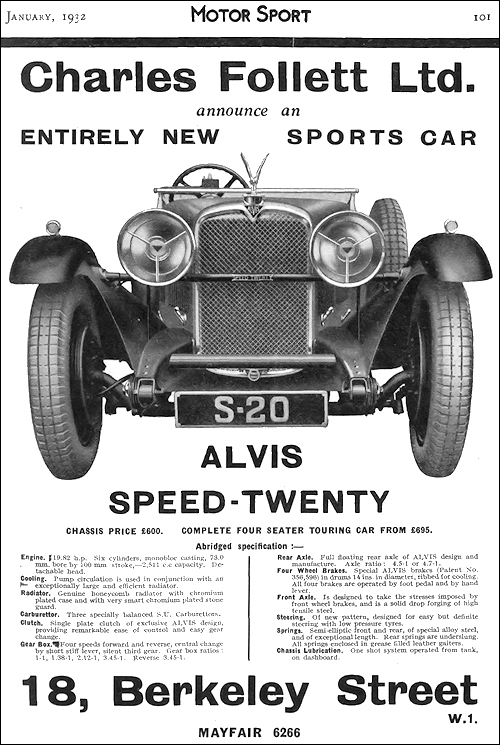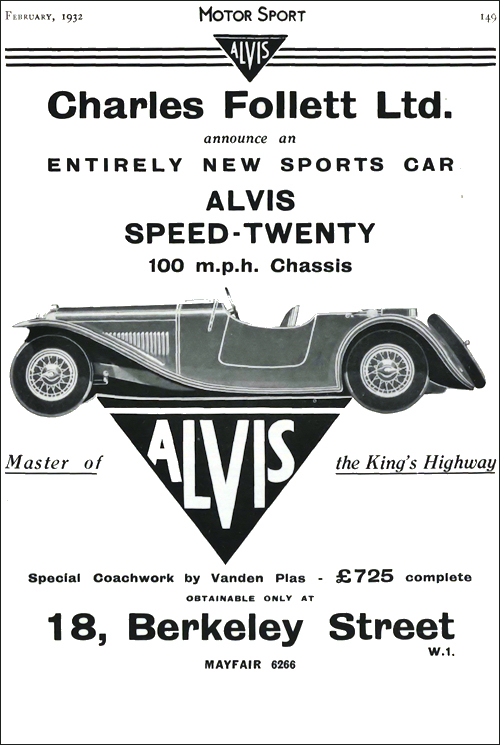
Classic Car Catalogue

The 12-50 h.p. remains in main essentials as before, but detail modifications have been made ; the radiator, for example, is now true honeycomb instead of , the film type previously used, and the coachwork is much improved and considerably smarter than in existing models.
The " twelve-sixty' model, it may be remembered was introduced about four months ago as a sports model, and has already achieved a great deal of popularity. It is of very robust build and capable of sustained high cruising speeds with a maximum of 75-80 m.p.h. The first batch of "Twelve-sixties" were fitted with bolted-on wire wheels, but the latest models now have the centre-fixing type, and a chromium plated stone-guard is a standard fitting.
The "Silver Eagle" Sixteen, which is perhaps the main product of the Alvis Company, remains much as hitherto except for minor details in the chassis and bodywork which have been improved in detail.
The "Silver Eagle" Twenty is a relatively new model, but although it was marketed for the first time only a few months ago, previous to this it underwent a year of testing and evolution. The engine size is 2,511 c.c. and an unusual feature is the fitting of three carburettors.
Prices and range are as follow :
Twelve-sixty sports : chassis £415, 2-seater £450, saloon £495.
Twelve-fifty : chassis £350, 2-seater £395, 4-seater £395, drop-head coupe £435, saloon £450.
"Silver Eagle" Sixteen : chassis £500, 2-3 seater £585, 4-seater tourer £595, "Atlantic" saloon £695, coachbuilt saloon £695.
"Silver Eagle" Twenty : chassis £550. "Atlantic" saloon £750, saloon £750.
Manufacturers' address : Alvis Car arid Engineering Co., Ltd., Coventry.

TL 12/60 Sports Saloon
Alvis TL 12/60 is available in chassis format £395 or complete as two-seater Sports (£450) and Sports Saloon (£495). The four-cylinder OHV engine is of 1645-cc (69 x 110 mm) capacity, rated at 11.8 HP. Power output is 52 bhp at 4000 rpm. The TJ 12/50 have basically the same engine but with 42-bhp output.





Silver Eagle 20 HP Limousine by Mayfair.
PARTICULARS OF THE "SPEED TWENTY."

The very pleasing appearance of the "Speed Twenty" is brought out well in this photograph. The extremely low and
well-balanced lines make it easily the most attractive sports model so far produced by Alvis concern.
well-balanced lines make it easily the most attractive sports model so far produced by Alvis concern.
If any criticism could have been levelled at the earlier Alvis models, it was chiefly that they did not appear to conform to the modern idea of low build. However, if this is achieved solely for appearance sake, without regard to other important factors it is useless, and the Alvis company have wisely waited until they are completely satisfied in every way with the new design before placing it on the market.
Further, the main components are developments of existing well-tried items of previous designs, and the car, while being definitely new in layout, performance, and many details, incorporates nothing which is not proved.
It is intended not only as a very fast car (85 to 90 m.p.h. with open touring body), but also as a quiet flexible machine which enables the performance to be used without fuss.

Some interesting features: The unit-constructed gearbox.

Some interesting features: The massive transverse frame member.
The chassis is of immensely strong construction with very deep side members and is sharply dropped between the front and rear axles to provide a really low body position. A very stiff girder type cross member is provided at the rear of the dropped portion, while very stiff rear cross members are placed to front and rear of the rear petrol tank, which is thus free from any strains or distortion.
The power unit is based on the well-known "Silver Eagle" and closely resembles it in external appearance. It is of 2½ litres capacity, being a six-cylinder of 73 x 100 mm. bore and stroke. Innovations include a rather heavier 4-bearing crankshaft, modified and enlarged valves and ports, and a higher compression ratio.
The cylinder head is detachable and has separate water connections to avoid using the head gasket as a water joint. Cooling is assisted by a water pump neatly disposed on the offside of the engine and coupled in tandem with the dynamo and magneto. Dual ignition is provided and a switch is fitted to employ either coil or magneto as required.
Mixture is supplied by 3 synchronised S.U. carburettors, to which fuel is supplied by an A.C. pump. A double pipe line arrangement provides for a reserve supply, operated by a handle within easy reach of the passenger.

Some interesting features: The big front brake drum.
For the first time this firm has employed unit construction of engine and gearbox, and a special feature of this is the accessibility of the various units, by no means a common feature of unit construction. The whole is mounted at 3 points on a special conical rubber mounting with the single mounting in the centre of the front chassis cross member.

The induction side of the engine, showing the three S.U.'s
and the A.C. fuel pump.
and the A.C. fuel pump.
The brakes are of new design and very ample size, and hand wheel adjustment within easy reach is incorporated.
Centralised chassis lubrication to all points is provided from a tank on the dashboard, so that this very important feature cannot be neglected, occasional operation of the handle being all that is required.
The gear box itself has a silent third gear with double helical teeth, while the lever is very short and conveniently placed.
The ratios are 15.7, 9.6, 6.25 and 4.55 to 1, while an alternative 4.7 axle ratio is also obtainable.
This latest Alvis is a most interesting newcomer to the sports car field, and at the very reasonable chassis price of £600 should immediately cause a heavy demand.


 FROM the inception of the Alvis company in 1919, their name has always been associated with the production of sports cars, and their products soon gained for themselves an enviable reputation for performance and excellence of material and manufacture.
FROM the inception of the Alvis company in 1919, their name has always been associated with the production of sports cars, and their products soon gained for themselves an enviable reputation for performance and excellence of material and manufacture.Many seasons of racing experience gave them valuable data for the building of their cars, one of their most notable victories being in the 200-miles race of 1924, when one of their famous 4-cylinder 1½-litre models, forerunner of the 12-60 h.p. of to-day, averaged over 94 m.p.h. for the distance, a very wonderful performance for a car which was but little modified from the production machine.
They kept an active interest in records and racing for some years, and only recently decided to wait till our present races give up the handicap system as the means of deciding the winner of the chief trophy.
When they announced their latest model, the "SpeedTwenty," motorists immediately became enthusiastic, and the description of the chassis which appeared in MOTOR SPORT at that time showed how neatly, and with what strength, the new model had been fashioned. Now that we have had an opportunity of testing an example for ourselves we have been able to realise that appearances were not deceptive, and the performance and handling were fully up to expectations.
This model owes a great deal in the power unit to the 3-carburettor Silver Eagle, but in the chassis layout itself, it is entirely new. Those who read our road test of the Silver Eagle in MOTOR SPORT of June, 1930, will remember that our verdict was roughly this—a fine car, but too high for the best results in cornering. Good cornering naturally depends on other things besides chassis height, and the Alvis Company were not to be rushed into producing a car which was low without having the other important factors a so brought into line, and their policy has been fully justified in the "Speed-Twenty."
Before describing our impressions of this car on the road, we will run through its main constructional features. The six cylinder monobloc engine has a detachable head, carrying the valves, these being operated by push rods. Separate water passages between head and block obviate the necessity of using the main gasket to seal the water joints.
The 4-bearing balanced crankshaft has oil fed through it to the main and big end bearings by a gear type pump driven from the shaft by spiral gears. The camshaft and auxiliary drives are taken from the rear end of the crankshaft through duplex roller chain with automatic adjustment. The valve rockers and push-rod ends are lubricated under pressure.
Mixture is supplied by 3 S.U. carburettors, and ignition by a B.T.H. polar inductor magneto and also by coil, the latter for starting and in the unlikely case of magneto trouble. The fuel is fed from the rear tank by an A.C. mechanical fuel pump. The 4-speed gearbox has a central change lever, and incorporates a silent third gear.
On the road the smoothness and silence of the engine were particularly pleasant, and enabled the car to be driven equally effectively on top gear under all circumstances of traffic, or hard on the gears as the driver's mood dictated. At first we did not feel that the acceleration was much out of the ordinary as it was so smooth and free from fuss and noise. It soon began to dawn on us, however, that other vehicles were overtaken with extraordinary facility, whatever gear was in use, and when we came to get the actual figures against the clock we found that they were really rather remarkable for a 2½ litre unsupercharged car in which weight has nowhere been skimped and strength has been the primary condition.
The only thing which prevents these figures being better still is the fact that the upward gear change is rather slow,—that is, unless brute force is used to engage the gears. This not being a good method of operation we did not employ it, and normally used, the gear is very pleasant and easily managed, though the necessary wait is bound to produce gaps in the acceleration curve.
 There was a very slight period at just over 2,000 r.p.m. in the engine we tried, but it was hardly noticeable, and at all other speeds up to 4,500 r.p.m. it was as smooth as could be wished. The driving position was comfortable, and the controls well arranged. The accelerator pedal, which is on the left of the brake, has an extension from the tip to the floor, and this makes it easily operated by the right heel when braking and changing down at the same time. This practice, which some racing drivers seem to imagine they have invented, but which is actually quite general on all sorts of vehicles where the pedals are suitably arranged, saves quite a lot of time and trouble in ordinary touring, especially in these days when we no longer drive on the hand brake.
There was a very slight period at just over 2,000 r.p.m. in the engine we tried, but it was hardly noticeable, and at all other speeds up to 4,500 r.p.m. it was as smooth as could be wished. The driving position was comfortable, and the controls well arranged. The accelerator pedal, which is on the left of the brake, has an extension from the tip to the floor, and this makes it easily operated by the right heel when braking and changing down at the same time. This practice, which some racing drivers seem to imagine they have invented, but which is actually quite general on all sorts of vehicles where the pedals are suitably arranged, saves quite a lot of time and trouble in ordinary touring, especially in these days when we no longer drive on the hand brake.The Alvis brakes are cable operated, the foot brake adjustment being easily operated by the driver while travelling, and they have a slight, but well controlled servo action. When applied hard they are extremely powerful, but are so progressive that locked wheels are rare, even on wet roads, and control is consequently excellent. From 40 m.p.h. the car can be stopped in 57ft. on wet, but not greasy, tarmac, without locking any wheels, and on a dry surface this already excellent figure can be improved on slightly.
The wet weather behaviour of this car is very good indeed, and brings out to the full the excellence of the weight distribution and steering.
When cornering fast it is not only free from rolling,— the low build sees to that—but the layout is such that it clings to the intended path at quite unexpected speeds, and when centrifugal force does eventually produce a skid it is of the rear wheels only, and easily controlled.
When we took over the car the suspension was too lively, as the Andre dampers were quite slack, but once these had been adjusted the springing was really good. The car held the road really well over all sorts of surface without being harsh, and a test carried out with a load of first one person and then no less than six, showed that the suspension is thoroughly self adapting to variation in load.
With regard to the shock absorbers we have one small criticism to make. The rear pair of these excellent fitments was so situated that it was necessary to crawl under the car to adjust them, access from above being, as far as we could see, barred by the batteries and cross member.
Although this car is as quiet and tractable as any touring model advertised as a "top gear motor," it is definitely fast. The maximum speed, as handed over to MOTOR SPORT, was 88 m.p.h. on the level, and would doubtless vary on different cars with different bodywork.
The hood on the standard tourer disappears very neatly and gives the car a very finished appearance when down. It is not, however, by any means quick to erect owing to the number of fasteners to undo and do up, and the hood itsel is not up to the very high standard set by the chassis as a whole. If a disappearing hood is to be used, there seems to be no reason why some adaption of the "Zip" fastener could not be used where it fits on to the body.
It is a very fine achievement, turning out the standard tourer at £695, and it is really remarkable value, both in quality and performance. For those who wish for something a little more individual or luxurious there is a most attractive range of coachwork by Van den Plas on this chassis. These are handled by Charles Follett, Ltd., of 18, Berkeley Street, W.1., the Alvis distributors, to whom we are indebted for the loan of the car tested by MOTOR SPORT.




Following the general design of the Speed Twenty chassis, the "Firefly" should be a worthy successor to the range of 1,500 c.c. cars produced by the Alvis Company. The four cylinder engine which is fitted with push rod operated valves and a single semi downdraught S.U. carburettor is mounted in unit with the four-speed gear box. The camshaft drive is taken from a sprocket mounted at the rear end of the crankshaft, and the engine is so smooth that a torsion damper is no longer required. A silent third gearbox is standard, but a self-changing box can be fitted instead.
The double-dropped chassis of the large car is retained, though slightly smaller in dimensions and the Alvis servo brakes are actually identical with those on the Twenty.
Prices are: open two seater £455, four seater £475 and saloon £495.

A car with a pedigree. The Alvis 'Firefly' comes from a racing stock.
The Alvis stand seemed to have more cars on it than any other in the Show. Probably the most attractive were the two "Speed Twenty" cars, open 4-seater and sports saloon, finished in grey and red, both of them thoroughbreds from stem to stern. The new "Firefly" was a good looking job, too, and the blue saloon had much more room in it than one generally associates with a 1½-litre car. The Alvis people have always been exponents of the 4-cylinder engine, and this new "Firefly" with all the experience derived from the old "12/50" and the later "12/60" models, should provide a 100% sound performance.
Races:
| Event: | Entered: | Raced: | Finished: | Best results: | ||||
|---|---|---|---|---|---|---|---|---|
|
|
H. Westbrook | 1,496 c.c. | 1st | |||||
|
|
1 | 0 | "Karachi" | 1492 cc | fail. | |||
|
|
C. G. H. Dunham | 2,511 c.c. | 3rd | |||||
Rallies:
| Event: | Entered: | Raced: | Finished: | Best results: | ||||
|
|
1 | Widengren | 17th | |||||
|
|
1 | 1 | 0 | Porter-Hargreaves | ret. | |||


